Karl Shuker's Blog, page 3
October 26, 2024
A FORMER FOXY FRIEND?
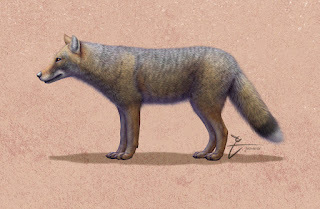 Reconstruction of the likely appearance in life of the officially-extinctArgentinian avus fox Dusicyon avus (©Juandertail/Wikipedia – CC BY-SA 4.0 licence)
Reconstruction of the likely appearance in life of the officially-extinctArgentinian avus fox Dusicyon avus (©Juandertail/Wikipedia – CC BY-SA 4.0 licence)South America's so-called foxes aremis-named, as these native wild dogs are more closely related to wolves anddomestic dogs than to the true, Old World foxes, genus Vulpes. They constitute several different species and genera, somevery much alive, others long extinct. And then there is one, Dusicyon avus, or Argentina's avus foxfor convenience, that although extinct today, died out only recently, in around400 BP (1454-1626 AD), and for mystifying reasons that have yet to beconclusively established.
Moreover, another, newly-revealed mysterysurrounds this enigmatic canid – was it the first (and only) mainland SouthAmerican fox species to have been domesticated by humans?
The reason for this unexpected line ofspeculation derives from a new and truly remarkable archaeological discovery –the remains of an avus fox purposefully buried inside a human grave dating back1500 years in a burial site at Cañada Seca, in Patagonia, Argentina.
Another avus fox had been found inside aneven older human grave almost a decade previously elsewhere in Argentina, atLoma de los Muertos in General Conesa, butwhat makes the later, Patagonian find so interesting is that whereas the dietof the earlier specimen had not been examined, DNA analysis has shown that thePatagonian specimen had dined with prehistoric hunter gatherers and was part oftheir camp's inner circle. Click here to access the original scientific paperformally documenting this research.
Commenting upon this find's extreme rarity,Dr Ophélie Lebrasseur from the University of Oxford opined here: "I think it was more thanjust symbolic; I really do think it was companionship".
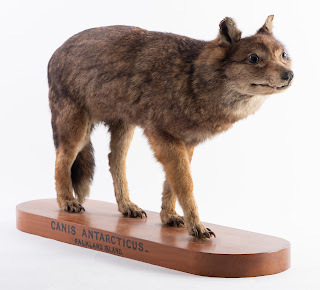 Taxiderm specimen of the Falklands Island wolf or warrah Dusicyon australis held at New Zealand'sTūhura Otago Museum (©
Kane Fleury/MothmanNZ/OtagoMuseum/Wikipedia –
CC BY 4.0 licence
)
Taxiderm specimen of the Falklands Island wolf or warrah Dusicyon australis held at New Zealand'sTūhura Otago Museum (©
Kane Fleury/MothmanNZ/OtagoMuseum/Wikipedia –
CC BY 4.0 licence
)
Also relevant is that the avus fox'sclosest relative is also nowadays extinct, but became so even more recently, in1876, after being not only hunted for its fur but also deliberately poisoned byfarmers concerned that it may pose a threat to their sheep.
Indigenous to the Falkland Islands and traditionallydeemed their only native species of land mammal, the so-called Falklands wolfor warrah D. australis has latelybeen considered by some researchers to have been introduced here indomesticated form by human voyagers from South America (worth noting is thatthe warrah was remarkably tame, wholly unafraid of humans).
Additionally, DNA analyses have revealedthat it diverged evolutionarily from the avus fox a mere 16,000 years ago. Inshort, a creature intimately allied to the avus fox was still alive as recentlyas the mid-1870s.
This leads me to wonder whether, as the avusfox's own historical, mainland extinction remains unresolved, perhaps that isbecause such an event never actually happened. That is, perhaps a remnant avusfox population still lurks scientifically undetected amid the wildernesses ofArgentina, within Patagonia's vast pampas expanses, having retreated there oncedomestic dogs arrived in South Anerica and supplanted the avus fox in theaffections of humans?
All of this is currently speculative, ofcourse, but fascinating nonetheless.
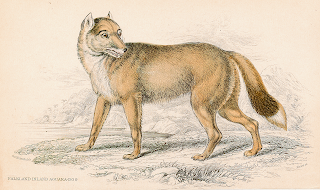 Vintage illustrationof the Falklands Islands wolf, by H. Smith, 1850 (public domain)
Vintage illustrationof the Falklands Islands wolf, by H. Smith, 1850 (public domain)
September 9, 2024
PUBLISHED TODAY, MY BRAND-NEW 35TH BOOK - 'SHUKERNATURE BOOK 4: TIJUANA'S ZEBRAS, TURKANA'S DANCING WORMS, AND OTHER IMPOSSIBLE BLOG BEASTS'
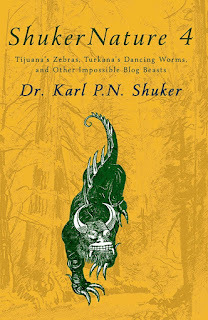 Featuringa vintage, suitably terrifying illustration of Wisconsin's hideous hodagglaring and frimacing at all potential readers, here is the front cover of mylatest book, ShukerNature Book 4 (©Dr Karl Shuker/Coachwhip Publications).
Featuringa vintage, suitably terrifying illustration of Wisconsin's hideous hodagglaring and frimacing at all potential readers, here is the front cover of mylatest book, ShukerNature Book 4 (©Dr Karl Shuker/Coachwhip Publications).Yes indeed – today, 9 Septembe 2024,marks the official publication of my latest, 35th book. The fourth,and final, volume in my tetralogy of anthology volumes compiled from mylong-running, award-winning ShukerNature blog, now in its 16th year,it is entitled ShukerNature Book 4: Tijuana'sZebras, Turkana's Dancing Worms, and Other Impossible Blog Beasts. Thatalone should give you at least a hint of the astonishing animals that you willbe encountering within its 400+ pages, but if you'd like more details, read on:
Evenwhen dealing with cryptozoology's variously, (in)famously elusive and illusivesubjects, there are certain examples that test the credulity of even the mostopen-minded, objective of investigators. This is because, based at least upontheir descriptions, they appear to be, albeit for many different reasons,simply impossible. Not implausible, not unlikely, not unfeasible, not incongruous,but impossible – or are they?
Afterall, who could believe in the existence of dragonflies with 6-ft wingspans, orspiders so huge that they can hunt down soldiers in the heart of Louisiana, oran unrealistically-reclusive Vietnamese deer whose antlers inexplicablyresemble the horns on a Viking's helmet, or a rapacious Beast (or Beasts) thatcarried out the wanton slaughter of terrified rural peasants despite the mostconcerted efforts made to end this very different Reign of Terror in France andstill remain unidentified over 300 years later, or all manner of kangaroo-likecryptids keeping researchers on the hop far beyond their Australasian homeland?Yet these have all been soberly reported, by sober observers.
Andwhat are the fascinating stories behind the horrific, hideous, horn-bearinghodag, or Tijuana's delightfully faux 'zebras', or the prehistoric worms thatdance beneath a tropical African moon and kill with a single bite, or how Imanaged to lose a multi-headed chimaera from Greek mythology but encounter theskull of a legendary Cornish sea monster, or the unexpected answers to averitable herd of quagga-themed queries, or how a magnificent yet hitherto-unrecordedpainting of what may conceivably be a murderous mystery cat from Tanzania wasdiscovered wholly by chance in an English charity shop?
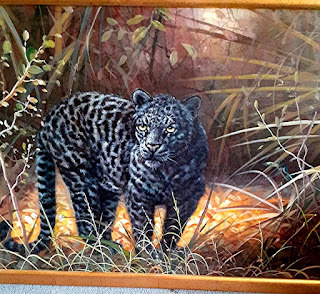 Close-up of a fascinating but highly mysterious paintingdocumented in my book that depicts an extremely distinctive big cat very closelyrecalling native descriptions of a exceptionally aggressive Tanzanian feline cryptidknown as the nunda or mngwa (photograph © Maxine Pearson; artist's identity stillcurrently unknown despite considerable investigations made by me)
Close-up of a fascinating but highly mysterious paintingdocumented in my book that depicts an extremely distinctive big cat very closelyrecalling native descriptions of a exceptionally aggressive Tanzanian feline cryptidknown as the nunda or mngwa (photograph © Maxine Pearson; artist's identity stillcurrently unknown despite considerable investigations made by me)
So,it's time to suspend disbelief and suppress doubt – for if you choose tosurrender to the secrets and surprises awaiting you inside my newest book, youmust prepare instead to encounter the reputedly unaccountable, witness theallegedly unimaginable, and be impressed by the ostensibly impossible!
Packed with lavish full-colour andhitherto-obscure b/w illustrations, containing an exhaustive bibliography, plusa detailed index, as well as updating and expanded many of the original blogarticles upon which its chapters are based, this fourth ShukerNature anthologygoes far beyond its online blog equivalent to provide its readers withunparalleled coverage of its beastly but breathtaking subjects.
Published by Chad Arment at CoachwhipPublications, ShukerNature Book 4 canbe purchased instantly and easily here on Amazon UK and here on Amazon USA, and can also be orderedthrough all good bookstores. So click away if you wish, and prepare as always withmy books to be amazed, astonished, and awe-struck by the monstrouslyfascinating menagerie eagerly awaiting inside its pages to meet you, greet you,and (if only they could break free!) eat you in a trice! Yes indeed, you know itmakes sense!
But seriously: fromstudies of medieval Norse illustrations of bizarre, ostensibly impossible seamonsters, not to mention even earlier Chinese depictions of strange, unfamiliar-lookinggibbons, and ancient Middle Eastern ones of long-vanished, long-unidentifiedequine enigmas, for example (and all documented in my book), it has becomeabundantly apparent that many major zoological discoveries of the future wereactually signposted very clearly in artefacts from the distant past, if onlyscientists and other scholars had recognized this. So who knows what additional'impossible' beasts are still to be revealed and verified as real by payingcloser attention to pictorial clues hidden in plain sight amid the antiquariesand relics from bygone times?
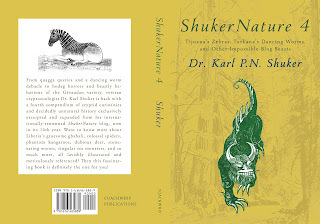 Fullcover wrap for my new book, featuring a vintage quagga image on the back cover (©Dr Karl Shuker/Coachwhip Publications)
Fullcover wrap for my new book, featuring a vintage quagga image on the back cover (©Dr Karl Shuker/Coachwhip Publications)
August 20, 2024
HIDING FROM THE HIDE? EERIE DEEPSEA ENCOUNTERS WITH ABYSSAL ABOMINATIONS
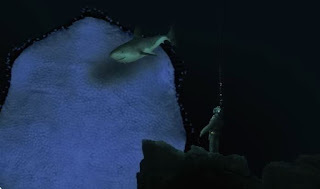 A photo-still from Encounter In The Abyss by RichardSvensson, depicting the nameless horror from the underwater abyss about toencapsulate the stricken shark while the terrified diver stood motionless, on aledge at the abyss's edge, watching in petrified fascination (© Richard Svensson)
A photo-still from Encounter In The Abyss by RichardSvensson, depicting the nameless horror from the underwater abyss about toencapsulate the stricken shark while the terrified diver stood motionless, on aledge at the abyss's edge, watching in petrified fascination (© Richard Svensson)Thedecidedly creepy cryptozoological report of a deadly underwater mystery beast documentedby me here today is one of my all-time personal favourites, which I've includedin several of my books and articles down through the years, and also previouslyon ShukerNature (click here). Now,thanks to a wonderful new animated short that brings the eerie encountervividly to life for the very first time (full details at the end of the presentblog article), I decided that it was time to revisit this terrifying denizen ofa deepwater abyss and provide some additional information, so here it is.
In1953, while testing a new type of deep-sea diving suit in the South Pacific, anAustralian diver named Christopher Loeb encountered a Lovecraftian horror fromthe ocean’s unpenetrated depths. In my book From Flying Toads To Snakes With Wings(1997) and also in my previous ShukerNature coverage of it, I provided amuch-abbreviated paraphrased version of Loeb's report, but here now is his fullfirst-person account, as originally provided by Eric Frank Russell in his own book GreatWorld Mysteries (1967:
All the way down I was followed by a fifteen foot shark whichcircled around full of curiosity but made no attempt to attack. I keptwondering how far down he would go. He was still hanging around some thirtyfeet from me, and about twenty feet higher, when I reached a ledge below whichwas a great, black chasm of enormous depth. It being dangerous to venturefarther, I stood looking into the chasm while the shark waited for my nextmove.
Suddenly the water became distinctly colder. While thetemperature continued to drop with surprising rapidity, I saw a black massrising from the darkness of the chasm. It floated upwards very slowly. As atlast light reached it I could see that it was of dull brown colour andtremendous size, a flat ragged edged thing about one acre in extent. Itpulsated sluggishly and I knew that it was alive despite its lack of visiblelimbs or eyes. Still pulsating, this frightful vision floated past my level, bywhich time the coldness had become most intense. The shark now hung completelymotionless, paralyzed either by cold or fear. While I watched fascinated, theenormous brown thing reached the shark, contacted him with its upper surface.The shark gave a convulsive shiver and was drawn unresisting into the substanceof the monster.
I stood perfectly still, not daring to move, while the brownthing sank back into the chasm as slowly as it had emerged. Darkness swallowedit and the water started to regain some warmth. God knows what this thing was,but I had no doubt that it had been born of the primeval slime countlessfathoms below.
Moreover,this may not be a unique report, for as revealed here by theonline Encyclopaedia of Cryptozoologywebsite:
According to Russian sources, at least two other sightings ofthe amorphous sea monster have been reported in local newspapers. Members of a Chileanhydrographic expedition to the South Pacific in 1968 told the press that theyhad seen an animal which resembled the Australian diver's "blackmass," near an abyssal trench. A fatal encounter with such an animalallegedly occurred off Thailand in 2005, when a French scuba diver named HenriAstor told the press that he had observed a very large "strange brownmass" paralysing and killing a shoal of fish. Astor's unnamed companionallegedly disappeared after attempting to follow the entity.
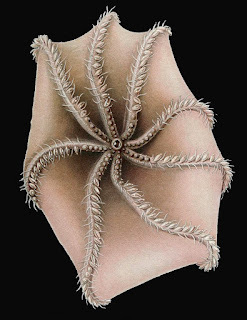 Cirrothauma murrayi
,
a species of deepsea cirrate octopus (public domain)
Cirrothauma murrayi
,
a species of deepsea cirrate octopus (public domain)
Inthe past, a deepsea octopus has been offered as a possible identity for thisdisturbing creature, but as I discussed in detail within my book, a far moresatisfactory candidate is a deepsea jellyfish, possibly akin to one of the knownrelatively shapeless types, such as Deepstariaenigmatica, which moves via peristalsis and lacks tentacles. This bizarrespecies remained undescribed by science until 1967, following its discovery by thefamous French oceanographer Jacques Cousteau while exploring the deep waters of the centralPacific Ocean near Southwest Baker Island in a submarine called Deepstar 4000. It is known from the Pacific Ocean,Antarctica, and the Gulf of Mexico, but only at depths below 3,000 ft.
Whereasall octopuses have tentacles, some deepsea jellyfishes do not. What they dohave, however, are potent stinging cells called nematocysts on their bodies(and tentacles if they possess any), armed with venom that swiftly paralysestheir prey. This would readily explain the immediate paralysis of the shark.Moreover, jellyfishes do not possess true eyes but they are equipped withsensory structures responsive to water movements. Consequently, the creaturewould have learnt of the shark’s presence by detecting its movements in thewater. How lucky, then, that the diver had remained stationary!
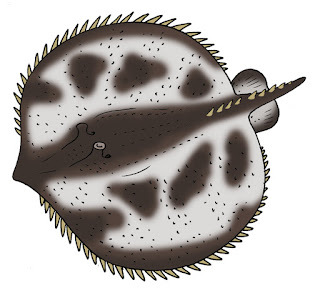 Artistic representation of el cuero, the deadly Chilean hide (© TimMorris)
Artistic representation of el cuero, the deadly Chilean hide (© TimMorris)
Interestingly,Chilean legends tell of a very similar beast called el cuero or the hide, as itis likened in shape and size to a cowhide stretched out flat, with countlesseyes around its perimeter, and four larger ones in the centre. As it happens,jellyfishes possess peripheral sensory organs called rhopalia that incorporatesimple light-sensitive eyespots or ocelli.
Moreover,some jellyfishes also have four larger, deceptively eye-like organs visible atthe centre of their bell. In reality, however, these organs are not eyes atall. Instead, they are actually portions of the jellyfishes' gut, known asgastric pouches, with the jellyfishes' horseshoe-shaped gonads sited directlyunderneath these pouches and also very visible (as in the familiar moonjellyfish Aurelia aurita).
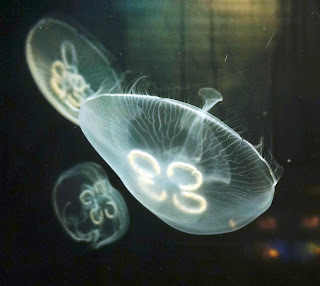 Moon jellyfishes Aurelia aurita(© Tila Monto/Wikipedia –
CC BY-SA 3.0 licence
)
Moon jellyfishes Aurelia aurita(© Tila Monto/Wikipedia –
CC BY-SA 3.0 licence
)
Soperhaps the deadly hide is more than a myth after all, lurking like so manyother maritime horrors reported down through the ages in the deep oceans'impenetrable black abyss, but only very rarely encountered by humankind – whichin view of the dreadful fate that befell the hapless South Pacific shark in1953 may be just as well!
And now, as noted above, this chillingcryptozoological vignette has been brought to vivid life by longstanding friendand awesome Swedish animator Richard Svensson, aka The Lone Animator, in awonderful 3-minute mini-movie entitled EncounterIn The Abyss, and available to watch for free on YouTube since 8 August2024 – just click here. Don't miss it!
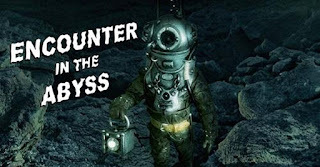 Thumbnailimage on YouTube for Encounter In TheAbyss by Richard Svensson (© Richard Svensson)
Thumbnailimage on YouTube for Encounter In TheAbyss by Richard Svensson (© Richard Svensson)
July 12, 2024
AN OYSTER-SCALED ODDITY FROM BRAZIL
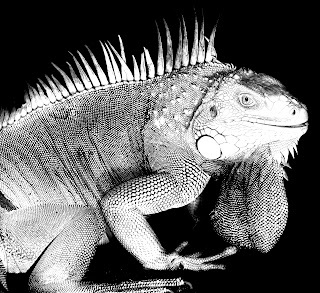 Isthis what Lerius's big white Brazilian lizard looked like? (modified from an iguanaphotograph © Carlos Andrés Reyes/Wikipedia –
CC BY 2.0 licence
)
Isthis what Lerius's big white Brazilian lizard looked like? (modified from an iguanaphotograph © Carlos Andrés Reyes/Wikipedia –
CC BY 2.0 licence
)One of the earliest mystery beast reportsemanating from the Americas came from the pen of French pastor and explorerJean Lerius (aka Jean de Lery), writing about the notable encounter in his veryinformative, highly influential book History of a Voyage to the Land ofBrazil, Also Called America(1578), which formally documented a wide range of South American animals forthe first time by a European.He was in the company of Admiral Nicolas Durand de Villegagnon, who in 1555 hadunsuccessfully attempted to establish a French Protestant colony on an island inthe bay of Rio de Janeiro, Brazil.
Approximately two years later, in orround 1557, Lerius and two other members of the company were trekking through aforest in the interior of Brazil with some local Tupinamba Indian guides butarmed only with swords or bows and arrows when, while passing through a deepvalley there, they abruptly encountered at a distance of only thirty paces orso a very large reptilian creature of extremely distinctive appearance,squatting on top of a hill in the heat of noon, with one of its forefeetraised. Lerius described it as a lizard bigger than the body of a man,measuring 5-6 ft long, yet its most eyecatching feature was not its size butrather its extraordinary tegument. For according to Lerius, this unfamiliaranimal was entirely covered in rough white scales that resembled oyster shells(and presumably, therefore, were opalescent, or nacreous, i.e. resemblingmother of pearl?).
 Illustrationof Jean Lerius (aka Jean de Lery) (public domain)
Illustrationof Jean Lerius (aka Jean de Lery) (public domain)
The astonished, petrified group of menand this albino-like reptilian apparition stared at one another for around 15minutes, all remaining totally immobile despite being directly exposed to theextreme heat of the mid-day sun, until the creature suddenly let forth a veryloud groaning sound before turning away and swiftly vanishing from sightthrough the foliage covering the hill. Needless to say, the men made no attemptto follow the monster, making their way instead along their original course,leading them far away from that hill and its dreadful denizen.
The fact that this sizeable lizard wasresting on top of a hill during the extreme mid-day heat clearly suggests thatlike lizards so often do, it was sunbathing, absorbing the sun's radiant heatfor thermoregulatory purposes. This is because lizards are ectothermic, i.e.poikilotherms, which are unable to regulate their body temperature via internalhomoiothermic mechanisms in the manner that endothermic mammals and birds do.
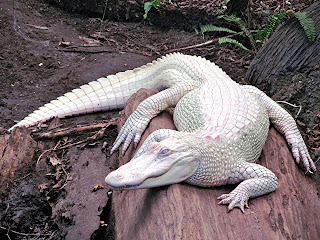 AlbinoAmerican alligator, (© Sherrif2966/Wikipedia –
CC BY-SA 4.0 licence
)
AlbinoAmerican alligator, (© Sherrif2966/Wikipedia –
CC BY-SA 4.0 licence
)
What is far less clear, conversely, isthis reptile's precise taxonomic identity, as no lizard of that size and pallidappearance is known from Brazil or, indeed, from anywhere else, today. Might ithave been albinistic, as I tentatively labelled it a little earlier here, orpossibly leucistic? Leucistic American alligators Alligator mississipiensis with shiny white scales but black eyesare well known, for example, as are other reptile specimens of similar form, aswell as true albino specimens with pink eyes. Perhaps it was a leucistic or analbinistic iguana, whose size had been over-estimated by an evidently shockedLerius. Or might Lerius have been incorrect in labeling it a lizard – could it haveactually been a white alligator?
I know of no other reports alluding tothis singularly distinctive reptile, so the riddle of what it was seems destinedto remain forever unsolved – like so many others in the fascinating iffrustrating chronicles of cryptozoology.
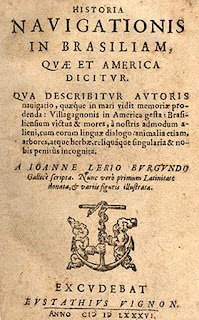 Titlepage of the Latin translation of Lerius's book, History of a Voyage to the Land of Brazil, Also Called America (publicdomain)
Titlepage of the Latin translation of Lerius's book, History of a Voyage to the Land of Brazil, Also Called America (publicdomain)
June 9, 2024
SHARING SOME MONSTROUSLY-ENTERTAINING CRYPTO-CREATURE FEATURE REVIEWS IN FORTEAN TIMES!
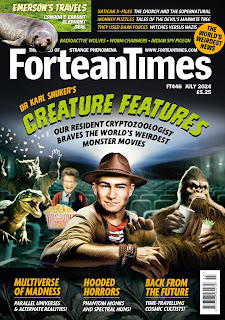 Frontcover of the current issue (#446, dated July 2024) of the British monthlymagazine Fortean Times, featuringyours truly as its cover star! (© David Sutton/Etienne Gilfillan/Fortean Times/Diamond Publishing Limited– reproduced here on a strictly non-commercial Fair Use basis foreducational/review purposes only)
Frontcover of the current issue (#446, dated July 2024) of the British monthlymagazine Fortean Times, featuringyours truly as its cover star! (© David Sutton/Etienne Gilfillan/Fortean Times/Diamond Publishing Limited– reproduced here on a strictly non-commercial Fair Use basis foreducational/review purposes only)One of ShukerNature's several sisterblogs and now in its fifth year of existence, my film review blog ShukerIn MovieLand hits the big time! A selection of itsFortean (and especially monster)-themed creature feature reviews has been compiledby me in the form of a monstrously-entertaining front-cover-linked lead articlethat has been published in the current issue (#446, dated July 2024) of theiconic British monthly magazine ForteanTimes, or simply FT to itsworldwide array of fans.
FT via its countle4sscontributors and readers down through the decades has been steadfastlyreporting and investigating across the vast and thoroughly fascinating spectrumof mysterious phenomena ever since the early 1970s (when it started out as The News), and I am very privileged tohave been contributing articles and news reports (the latter via my regular,longstanding Alien Zoo column) ever since the 1990s, concentrating uponcryptozoology and animal anomalies of every conceivable (and inconceivable!) kind.
Moreover, as readers of Shuker InMovieLand already know (as do more than a fair few ShukerNature readers too), Iam also passionately interested in movies, particularly fantasy and scifi-themed ones, but never more so than those that incorporate monsters andother mystery or fantastical beasts. So in my latest FT article as now highlighted here, I have collated a diverseselection of my Shuker In MovieLand reviews of creature features that I have verymuch enjoyed watching over the years. And I hope that it will encourage ShukerNature'snumerous fellow beast-movie buffs to watch and enjoy them now too.
I'm not going to say anything moreregarding my article's contents, so as not to spoil the surprises awaiting FT readers, but I do wish to express mysincere thanks to FT's editor DavidSutton and its art director Etienne Gilfillan for making my article an FT reality, with Etienne not only doingus all proud in not only assembling the dazzling collection of illustrationsaccompanying its text but also creating the front cover's truly amazing associatedartwork!
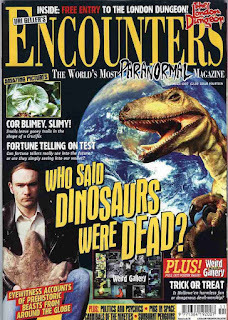 Anothermagazine front-cover appearance, from issue #14 (November 1997) of the nowlong-defunct British monthly magazine Uri Geller's Encounters, to whichI contributed a number of cryptozoological articles (
©
Nina Pendred/Paragon Publishing Ltd – reproduced here on a strictly non-commercialFair Use basis for educational/review purposes only)
Anothermagazine front-cover appearance, from issue #14 (November 1997) of the nowlong-defunct British monthly magazine Uri Geller's Encounters, to whichI contributed a number of cryptozoological articles (
©
Nina Pendred/Paragon Publishing Ltd – reproduced here on a strictly non-commercialFair Use basis for educational/review purposes only)
No doubt you'll recognize the veryhandsome chap (cough cough!) attired in best Indiana Jones accoutrements takingcentre stage on the FT cover as heprepares to cinematically confront a veritable host of horrors...and that'sjust the audience! – ormost of it. For I also wish to highlight the delightful fact that the happylittle lady with the extra-large box of popcorn is none other than my dear littleMom, Mary Shuker, who always enjoyed watching monster movies with me back inthe good old days. How I wish that she were still here, to know that she wasnow a front-cover star! She would have been so proud. Thank you so much,Etienne, for such a wonderful and very touching tribute to her.
So, be sure to seek out and purchase acopy of FT #446 if you can (it's outnow!), and have a monstrously good time reading about some very varied creaturefeatures of the cryptozoological and zoomythological kind. Go on, you know youwant to!
For mor information concerning FT, please click here to visit its official website.
Finally:to view a complete chronological listing of all of my Shuker In MovieLandblog's film reviews and articles (each one instantly accessible via a directclickable link), please click HERE, and please click HERE to view acomplete fully-clickable alphabetical listing of them.
 Close-upof the front cover of FT #446,showing Mom happily selling popcorn to a truly beastly audience! (© DavidSutton/Etienne Gilfillan/Fortean Times/DiamondPublishing Limited – reproduced here on a strictly non-commercial Fair Usebasis for educational/review purposes only)
Close-upof the front cover of FT #446,showing Mom happily selling popcorn to a truly beastly audience! (© DavidSutton/Etienne Gilfillan/Fortean Times/DiamondPublishing Limited – reproduced here on a strictly non-commercial Fair Usebasis for educational/review purposes only)
April 29, 2024
VALERO'S ROCK JAGUAR AND RED JAGUAR - TWO LESSER-KNOWN BRAZILIAN MYSTERY CATS
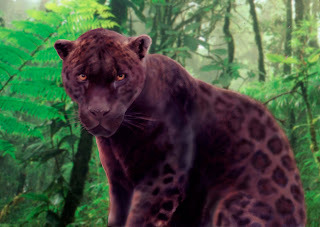 Did Valero's kintanari look something like this? (©William M. Rebsamen)
Did Valero's kintanari look something like this? (©William M. Rebsamen)
Americancorrespondent Ted Leonard kindly brought to my attention some years ago afascinating book that mentions two Brazilian mystery cats that were previouslyunknown to me.
Writtenby Ettore Biocca, first published in English in 1970 (it was originallypublished in Italian), and based upon firsthand testimony related to him by itssubject, the book is Yanoáma: The Narrative of a White Girl Kidnapped byAmazonian Indians. It recounts the remarkable true-life story of HelenaValero, who was abducted as an 11-year-old Italian girl by Yanoáma natives backin the 1930s and reared by them in the Amazonian jungle.
One ofthese crypto-felids was known locally as the rock jaguar, and was brieflywitnessed one day by Valero while in the company of some Yanoáma women andhunters. She described it as follows:
It was morning that day and we had seen among the rocks, as if in awindow, a jaguar's head. It was a kind of jaguar which I did not know: itwasn't one of those spotted ones or those red ones that they call kintanari.It was a brown jaguar and it had long hair on its head: it was the rock jaguar.
Ifthis description is accurate and authentic, I suspect that it was not a jaguarof any kind, but rather some other, unidentified large-sized cat, brown incolour, with what seems to have been a mane. Intriguingly, that is not the onlydescription on record of such a felid from South America, as a maned mysterycat has also been reported from Ecuador (see my mystery cat books for further details).
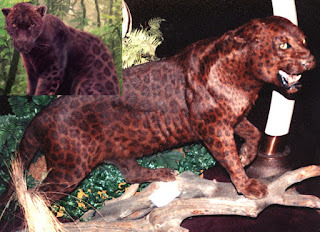 A taxiderm specimen of an apparent reddish leopard(seemingly not sun-faded) spied and photographed by Bill Rebsamen, plus Bill's redjaguar painting (inset) (both images © William M. Rebsamen)
A taxiderm specimen of an apparent reddish leopard(seemingly not sun-faded) spied and photographed by Bill Rebsamen, plus Bill's redjaguar painting (inset) (both images © William M. Rebsamen)
Butwhat of the equally anomalous kintanari or red jaguar that Valero alluded to?Unfortunately, that single brief mention quoted above is the only time thatthis strange creature is referred to anywhere in the book.
Justas there are freak all-black (melanistic) and all-white (albinistic) jaguar individuals on record, might there also beoccasional all-red (erythristic) specimens? Certainly, erythristic individualshave been documented with certain other felid species, including the leopard,tiger, and jaguarundi. Alternatively, perhaps it was not a jaguar at all, butinstead some other large felid, with reddish fur - a burly rufous puma, possibly?
And justin case you were wondering about the taxiderm specimen of a reddish leopard depictedabove, here’s what I wrote about it in my book Cats ofMagic, Mythology, and Mystery (2012):
THEBLACK PANTHER THAT WAS RED!
On 12September 1998, American wildlife artist Bill Rebsamen was in Springfield,Missouri, and paid a visit to the Bass Pro Shop's famous Fish and WildlifeMuseum. It possessed many spectacular exhibits - but none more so, at least inBill's eyes, than a certain taxiderm-mounted big cat of amazing appearance (as seen in Bill's photo of it above). Itresembled a black panther (i.e. a melanistic leopard), patterned with dark rosettes - but instead of itsfur's background colouration being black or dark brown, it was instead a richmahogany-red!
I haveseveral cases on file of erythristic leopards, i.e. mutant individuals whosefur was reddish (including the rosettes) instead of yellow (with blackrosettes), the most recent being the so-called 'strawberry leopard' latelyspied within South Africa's Madikwe Game Reserve and photographed there bysafari guide Deon de Villiers (National Geographic News, 12 April 2012 [several additional strawberry leopards have ben observed and photographed in Africa since then]),but no previous data concerning red-furred black panthers. Sometimes, a darktaxiderm specimen fades during the course of time, the mounted skin becomingbrown in those areas exposed to sunlight - as from a nearby window, forinstance. However, Bill viewed this panther from every angle, front and back,and could see no sign of fading on any portion of its skin; it was uniformlyred all over.
This ShukerNature blog article is excerptedand enlarged from my book Mystery Cats of the World Revisited (2020),the greatly-expanded, fully-updated second edition of MysteryCats of the World (1989), long recognized as the definitivebook on crypto-felids.
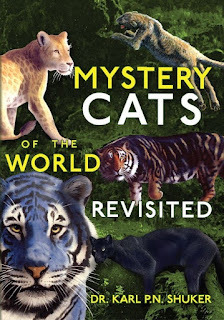 Mystery Cats of the World Revisited
(© Dr Karl Shuker/Anomalist Books, front cover artwork © WilliamM. Rebsamen)
Mystery Cats of the World Revisited
(© Dr Karl Shuker/Anomalist Books, front cover artwork © WilliamM. Rebsamen)
March 30, 2024
REVIEWING 'CARNIFEX' - A CRYPTOZOOLOGY-THEMED CREATURE FEATURE FROM DOWN UNDER
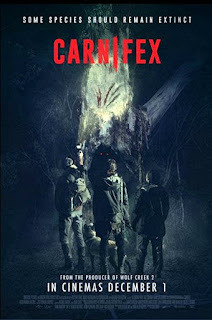 Publicityposter for Carnifex, showing the charactersgazing up in awe at some formidable claw marks left upon a tree trunk by a large unknown animal of seeminglyarboreal ability (© Sean Lahiff/Dancing Road Productions/Arclight Films/UniversalPictures Content Group – reproduced here on a strictly non-commercial Fair Usebasis for educational/review purposes only)
Publicityposter for Carnifex, showing the charactersgazing up in awe at some formidable claw marks left upon a tree trunk by a large unknown animal of seeminglyarboreal ability (© Sean Lahiff/Dancing Road Productions/Arclight Films/UniversalPictures Content Group – reproduced here on a strictly non-commercial Fair Usebasis for educational/review purposes only)Thanks to longstanding Australian FBfriend and crypto-enthusiast Tim Morris kindly making it available to me -thanks Tim! – my movie watch on 26 October 2023 was the fairly recent Australiancryptozoology-themed creature feature Carnifex.
Directed by Sean Lahiff, and releasedjust a year ago in December 2022 by Universal Pictures, Carnifex takes its name in a general sense from the Latin word for'butcher' or even (during the Roman era) 'executioner'. However, wildlife enthusiasts,especially cryptozoologists, will also be aware of its more specific,zoological meaning.
Consequently, if you're of the latterpersuasion, you will have no doubt guessed straight away from this movie'stitle that while conservationists Ben (Harry Greenwood) and Grace (SisiStringer) accompanied by documentary camerawoman Bailey (Alexandra Park) areuncovering and recording deep within the Australian outback the vast wildlifedevastation caused there by some recent, unprecedented bushfires, they also makethe startling, totally unexpected, and truly terrifying discovery of a livingmarsupial lion Thylacoleo carnifex. Foronce they do, they also discover – very swiftly – just how hyper-aggressive andrapacious the creature is, forcing them into a desperate bid for survival againstthis mega-belligerent blast from the past, their thoughts echoing only too emphaticallythe film's tagline: "Some species should remain extinct".
This ferocious species was – or is? – a predatory pouched mammal of feline form, leopardor lioness stature (opinions vary), and possibly arboreal capabilities, but officiallydeemed extinct for many millennia. However, some cryptozoologists feel that itsputative reclusive survival into the present day may explain occasional reportsof an Aussie mystery beast known as the yarri or Queensland tiger. It may evenhave inspired the spoof killer koala called the drop bear (koalas and marsupiallions were actually quite closely related). Most of this pertinent background information,however, is never alluded to in the movie, sadly.
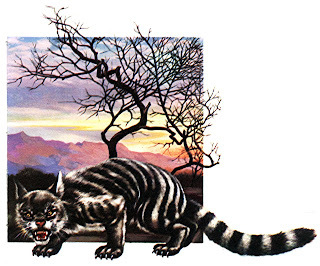 Yarrior Queensland tiger, based upon eyewitness descriptions (© Dami Editore srl – reproducedhere on a strictly non-commercial Fair Use basis for educational/review purposesonly)
Yarrior Queensland tiger, based upon eyewitness descriptions (© Dami Editore srl – reproducedhere on a strictly non-commercial Fair Use basis for educational/review purposesonly)
Speaking of which: its build-up to thisvery dramatic discovery, although very lengthy (see later), is engrossing, andfeatures a trio of lead likeable characters that interact well together,interspersed with plenty of breathtaking shots of genuine Aussie Outback Nevertheless,Carnifex suffers from two verysignificant, crucial problems.
Firstly, once the story truly gets going,it consists almost entirely of night-time scenes, resulting in actual sightingsof the creature (with totally black pelage, thereby rendering it even more difficultto see against the darkness) being asshadowy and brief as they are seldom and inconclusive, i.e. plenty of growlingand flesh-tearing sounds, but visually all but non-existent.
Secondly, when in this 90-odd-minutemovie's last 10 minutes we finally - finally! - get to see twoblink-and-you'll-miss-them close-up full-face shots of the (very) anatagonisticanimal in question (so fleeting in fact that after seeing them I then had torewind and laboriously seek them out via freeze-frame in order to be sure ofwhat they actually revealed – something, incidentally, that cinema audiencesfor this movie would not have had the luxury of being able to do), guess what?
The film makers had only gone and gottheir Thylacoleo carnifexfundamentally wrong – and after having kept their increasingly impatientviewers waiting so long to see it properly too!
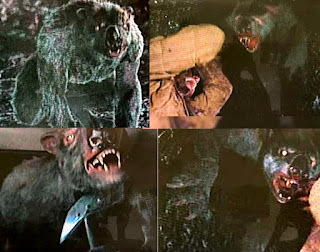 Aselection of photo-stills from Carnifexdepicting the latter beast's brief appearances and, especially, its dentition – click picture montage to enlarge for viewing purposes (©Sean Lahiff/Dancing Road Productions/Arclight Films/Universal Pictures ContentGroup – reproduced here on a strictly non-commercial Fair Use basis foreducational/review purposes only)
Aselection of photo-stills from Carnifexdepicting the latter beast's brief appearances and, especially, its dentition – click picture montage to enlarge for viewing purposes (©Sean Lahiff/Dancing Road Productions/Arclight Films/Universal Pictures ContentGroup – reproduced here on a strictly non-commercial Fair Use basis foreducational/review purposes only)All placental carnivores have fangsconsisting of enlarged upper canine teeth (and so too, for that matter, does,or did, the thylacine or Tasmanian marsupial wolf Thylacinus cynocephalus, officially deemed extinct in 1936 butwhich may still linger on in this island's more remote regions). In starkcontrast, conversely, the tusk-like fang counterparts of Thylacoleo were actually greatly-enlarged upper incisors (it alsosported a pair of extremely enlarged lower incisors, but its upper canines wereonly very small and stubby). Yet in this movie, its Thylacoleo has been given enlarged upper canines, not incisors,thereby rendering their Carnifex dentally deranged!
Moreover, the two close-up shots of itsfront paws also revealed a telling absence of the huge thumb claw constitutinganother morphologcal characteristic of this unique predator.
Judging from these major morphological discrepancies,I can only assume that someone apparently hadn't done their zoological homeworkwhen researching T. carnifex for thisCarnifex-entitled movie. Needless to say,this is a great shame, especially as otherwise it is a most enjoyable film, withengaging characters amid the savage beauty of the Australian bush, and it wouldhave been a wonderful showcase for a truly original animal antagonist neverpreviously represented in a cinematic role.
Then again, it is fair to say that many viewersare unlikely to have in-depth knowledge of thylacoleonid dentition anyway. So theywill simply not notice or recognize the inaccuracy of the latter's depiction inthis movie (particularly as it has no effect upon the plot itself), thereby enablingthem to enjoy the movie as an otherwise very watchable, well-presented conservation-mindedcreature feature, especially one produced by a small independent film company asopposed to a mega-bucks Hollywood studio. Also on the positive side, it doesmean that a morphologically-accurate 'living Thylacoleo'-themed monster movie is still waiting to be made.
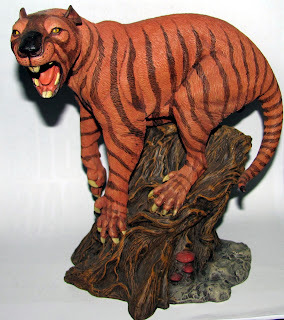 Thylacoleo carnifex
model produced by Jeff Johnson and owned by Rebecca Lang, two longstandingFacebook friends of mine (© Jeff Johnson/Rebecca Lang – reproduced here on a strictlynon-commercial Fair Use basis for educational/review purposes only)
Thylacoleo carnifex
model produced by Jeff Johnson and owned by Rebecca Lang, two longstandingFacebook friends of mine (© Jeff Johnson/Rebecca Lang – reproduced here on a strictlynon-commercial Fair Use basis for educational/review purposes only)
Incidentally, a novel written byAustralian horror author Matthew J. Hellscream (I'm guessing that this may be apseudonym…) that was published in 2016, i.e. 6 years before the present movie under review here was released, was alsoentitled Carnifex, and also featured somevisitors to a remote area of the Australian bush encountering living but scientifically-undiscoveredmarsupial lions. According to various AdelaideAdvertiser articles, Hellstream took legal advice when the movie came outbecause of perceived title and plot similarities, but that is not what I amconcerned with here. What I amconcerned with is that the very striking illustration of one such beast presenton the front cover of Hellstream's novel depicts it with totally accuratedentition – click here to view it, and take note of thegreatly enlarged incisors, and all but absent canines, plus the shearing blade-likecarnassials further back.
I don't own a copy of this novel (yet),but I've heard tell that the cover artwork was prepared by acclaimed horrorartist Frank Walls, who created the front cover for Hellscream's previousnovel, Metro 7, but I can't confirm this.Whoever did design it, however, clearly made the effort to portray accurately theunique dentition of this truly unique mammalian predator.
Anyway, if you'd like to peer through thedarkness of the Outback at night in search of the toothy terror lurking in thismovie, be sure to click here to watch an official Carnifex trailer on YouTube.
Finally:this review originally appeared in ShukerNature's fellow blog, Shuker In MovieLand. To view a complete chronological listing of all of my Shuker In MovieLandblog's other film reviews and articles (each one instantly accessible via adirect clickable link), please click HERE, and please click HERE to view acomplete fully-clickable alphabetical listing of them.
 Mybook
Still InSearch Of Prehistoric Survivors
(2016), which contains a very comprehensive coverage of the yarri or Queenslandtiger, and featuring prominently in the bottom-left portion of its front coveran artistic representation by cryptozoology artist William M. Rebsamen of whatthis elusive, mysterious creature may look like if it is indeed a survivingrepresentative of the marsupial lion Thylacoleocarnifex, complete with accurate dental depiction for the latter species (©Dr Karl Shuker/William M. Rebsamen/Coachwhip Publications)
Mybook
Still InSearch Of Prehistoric Survivors
(2016), which contains a very comprehensive coverage of the yarri or Queenslandtiger, and featuring prominently in the bottom-left portion of its front coveran artistic representation by cryptozoology artist William M. Rebsamen of whatthis elusive, mysterious creature may look like if it is indeed a survivingrepresentative of the marsupial lion Thylacoleocarnifex, complete with accurate dental depiction for the latter species (©Dr Karl Shuker/William M. Rebsamen/Coachwhip Publications)
March 2, 2024
THE GRUESOME GBAHALI - LURKING IN LIBERIA?
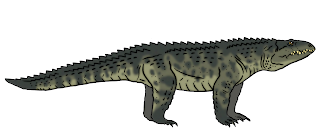 Representation of the gbahali based uponeyewitness descriptions (© Tim Morris)
Representation of the gbahali based uponeyewitness descriptions (© Tim Morris)Since1900, the West African country of Liberia, still plentifully supplied withcoastal mangrove swamps and interior rainforests, and long deemed abiodiversity hotspot by zoologists, has been the scene of at least four majorzoological discoveries of species new to science or rediscoveries of speciesbelieved extinct. Namely, the giant forest hog Hylochoerus meinertzhageni, the pygmy hippopotamus Choeropsis liberiensis, Jentink's duikerCephalophus jentinki, and theLiberian mongoose Liberiictis kuhni.
All ofthese are mammals, of course, but there is also some thought-provoking evidenceto suggest that a fifth major zoological find is still waiting to be made here– and this time of the reptilian variety.
 West Africa's dwarf crocodile, note its shortsnout (public domain)
West Africa's dwarf crocodile, note its shortsnout (public domain)
Fourspecies of crocodilian are known to exist in Liberia. These are the Nilecrocodile Crocodylus niloticus, thedwarf crocodile Osteolaemus tetraspis,the West African slender-snouted crocodile Mecistopscataphractus, and the West African or sacred crocodile C. suchus (only quite recently delineated from the Nile crocodileas a valid distinct species in its own right). The first two are restricted tothis country's coastal swamps, and are considered rare, as is the third (alittle-studied, human-avoiding species), whereas the fourth one, which occursfurther inland, is quite common.
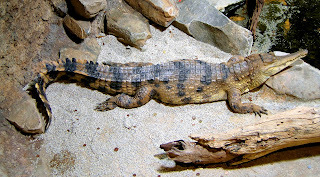 West African slender-snouted crocodile (©Thesupermat/Wikipedia –
CC BY-SA 3.0 licence
)
West African slender-snouted crocodile (©Thesupermat/Wikipedia –
CC BY-SA 3.0 licence
)
However,native Liberians also speak of a fifth crocodile-like creature, currentlyunknown to science, which they refer to as the gbahali (pronounced 'bar-hye'),and consider to be larger and more dangerous than even the Nile crocodile –itself a highly aggressive, notorious man-eater that can grow up to 21 ft long.
Thegbahali first attracted widespread Western attention on 20 December 2007, whenveteran American cryptozoologist Loren Coleman published on the mystery beastwebsite Cryptomundo a communicationthat he had received the previous day. It was from a correspondent namedJohn-Mark Sheppard (some accounts spell his surname as Shephard) – an Americanmissionary working at that time with an international relief and developmentorganisation in northernmost Liberia's Lofa County, near this country's borderwith Guinea.
In hiscommunication, Sheppard revealed that he had learnt from the indigenous peoplethere about several strange, unidentified creatures that may be of potentialcryptozoological interest, including the gbahali. He had spoken to a number ofalleged eyewitnesses who claimed to have seen the latter mystery beast inrecent years, and according to their testimony, as documented by Sheppard:
It is described as being like a crocodile or monitorlizard, but much larger (up to 25 or 30 ft long). It has an armored back withthree rows of serrations running down it, a powerful tail, and a short snoutwith many large teeth. It is known to be an ambush predator, carrying its preyunderwater to drown before coming on shore to eat it.
Sheppardeven travelled to a village deep in the Liberian rainforest where the fishermenclaimed to have actually caught gbahali specimens, using nets to capture themand shotguns to kill them, before butchering their carcases for meat, whichthey then sold at local markets. They had even preserved the skull of one suchspecimen, which had been retained in the village until rebels invaded it duringthis country's civil war (which ended in 2003) and set it ablaze, destroyingeverything there, including that scientifically-precious gbahali skull.
Wheninterviewing the villagers, Sheppard showed them various illustrations ofmodern-day and prehistoric crocodilians and crocodilian-like animals that hehad downloaded from the internet. Of these, the creature that they consideredmost similar in appearance to the gbahali was an artistic reconstruction of thelikely appearance in life of a prehistoric reptile from North America's Late TriassicPeriod, known as Postosuchus. Thisvery sizeable beast, up to 6 m long, belonged to a long-extinct taxonomicfamily whose members, known as rauisuchians, were related to crocodilians.
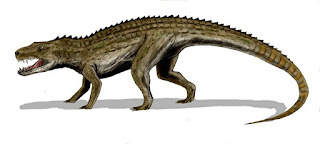 Representation of the possible appearance in lifeof Postosuchus in quadrupedal mode (©Nobu Tamura/Wikipedia –
CC BY-SA 3.0 licence
)
Representation of the possible appearance in lifeof Postosuchus in quadrupedal mode (©Nobu Tamura/Wikipedia –
CC BY-SA 3.0 licence
)
Thelocals stated that the head and body of Postosuchusas depicted in the artistic reconstruction resembled that of the gbahali,but that its legs were more erect (i.e. supporting its body from below) thanthe gbahali's, which are allegedly semi-erect in stance (i.e. more sprawling),like those of crocodilians.
Continuinghis narrative, Sheppard stated:
The river in which these creatures are said to liveis very remote, passing through large areas of uninhabited forest. They are saidto mainly be seen during the rainy season, when they travel upstream to lookfor food. They are greatly feared by the local population, because they havebeen known to kill people.
Indeed,according to Sheppard one such incident may have occurred as recently asNovember 2007, just a month before he had sent his communication to Coleman. Aman had been attacked and killed by a possible gbahali near a village namedGelema, on that selfsame river. When the United Nations police were sent thereto investigate this incident, all that they could find was the victim's headand a few body parts that the creature had left behind on the river bank. Thisties in with local claims mentioned above by Sheppard whereby the gbahalidrowns its victim, then comes ashore with their dead body to consume it there.
Worthyof note, incidentally, is that back when Gelema's official town meeting housewas built, its length was deliberately constructed so as to correspond withthat of a gbahali that had been killed there some years previously.Consequently, this grim mystery beast would indeed appear to be native to thearea encompassing Gelema.
Alsoof interest, as specifically pointed out by Sheppard when concluding hisaccount of the gbahali, the local people do not consider this beast to be inany way magical or supernatural. Instead, they simply look upon it as justanother normal, ordinary animal native to their locality (albeit a very large,dangerous one), nothing more – which in turn tends to lend plausibility totheir testimony concerning it.
Sheppardended with a tantalizingly brief mention of a photograph that had supposedlybeen taken of a gbahali sometime in the previous 10 years during an attempt tocapture this creature, but he made no mention of what had happened to it,always assuming of course that such a picture had indeed been obtained.
Afterspending many years behind the camera as a first-rate, highly-acclaimed film/TVcameraman and cinematographer, in 2017 Paul 'Mungo' Mungeam stepped in front ofit to present a new cryptozoology-themed TV documentary show entitled Expedition Mungo. Each of its episodes(filmed in 2016 and early 2017) saw him and his own film crew visit a differentlocation around the world allegedly inhabited by a mysterious creatureseemingly unknown to science. One of these episodes saw them in Liberia's LofaCounty, seeking the gbahali, and where they actually interviewed Sheppard onscreen.
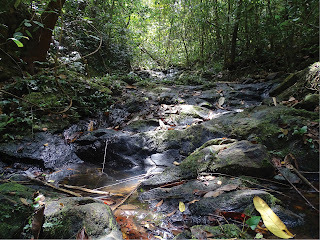 Rainforest in Liberia's Lofa County (©) M Rödel et al./Wikipedia –
CC BY 4.0 licence
)
Rainforest in Liberia's Lofa County (©) M Rödel et al./Wikipedia –
CC BY 4.0 licence
)
Mungo'sgbahali expedition focused its attention upon the Kahai River and itstributaries, where this greatly-feared creature is known by the locals to existand where, therefore, they avoid as much as possible unless it is absolutelyessential to cross from one riverbank to another or to hunt for food there. Onevillager named Momo informed Mungo that he and his brother had encountered aghahali on land once while they were hunting on the Kahai River, but once seenit disappeared into the water.
Discountingthe possibility that it was merely a crocodile, Momo stated that its head waslizard-like but with its eyes placed far back on it, a trait often exhibited byaquatic animals, and its teeth were interlocking. Moreover, although it walkedon all fours like a crocodile, its body was raised up, held off the ground to agreater degree than a crocodile's is. He also mentioned to Mungo that one suchcreature had killed and devoured three men who had been attempting to cross theKahai on a raft at dusk.
Similarly,another alleged gbahali eyewitness interviewed by Mungo, a man named Isaac fromMonena, a remote Liberian frontier village, recalled an oft-told claimedkilling of a man in a shallow river by a gbahali. The man had been attemptingto cross the river on foot to reach a party of fisherman friends on the farbank. His friends told him not to cross, because a gbahali had been seen thereearlier that same day, but he ignored their advice and proceeded to wadeacross. Before he could reach the other side, however, a gbahali surfaced,seized the man, and dragged him beneath the water, never to be seen again.
As forIsaac's own sighting, which had occurred not long before Mungo had arrived atMonena in early 2017: just like Momo, Isaac had been fishing with his ownbrother on the river nearby when he saw something swimming towards his brother:
He turned around and said:"It looks like a crocodile". I said: "Hey, that is not acrocodile, that is an animal bigger than a crocodile". We're talking aboutthe Gbahali...The mouth was in the form of a lizard.
Isaacestimated the gbahali to have measured around 20 ft long, and insisted that itwas very different in appearance from a crocodile.
Alsointerviewed by Mungo at Monena was fisherman Seiku, who divides his timebetween this village and a camp on an even more remote stretch of the Kahai.Seiku claimed to have seen a gbahali twice during his travails along this routein September 2016, again not long before Mungo's arrival here.
Severalother villagers interviewed by Mungo at Monena also claimed to have seen agbahali, but as Sheppard had discovered earlier during his own investigations,they did not consider it to be in any way magical or paranormal, just a normal,ordinary creature like all of the other animal species inhabiting thislocality.
Sadly,Mungo and his team did not have any sightings of their own, but if, asfervently averred by Liberia's Lofa County hunters and fishermen, the gbahaliis indeed a real, flesh-and-blood beast, what might it be?
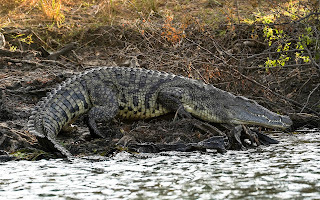 Nile crocodile (© Timothy A Gonsalves/Wikipedia –
CC BY-SA 4.0 licence
)
Nile crocodile (© Timothy A Gonsalves/Wikipedia –
CC BY-SA 4.0 licence
)
Themost conservative identity is the Nile crocodile (Liberia's other threecrocodile species are much too small and/or wary of human proximity). Althoughofficially confined to this country's coastal swamps, perhaps some stragglershave penetrated further inland, reaching rivers, tributaries, and surroundingterrain containing plenty of suitable prey, enabling them to thrive andestablish viable populations there, and possibly eventually attaining greatersizes than their coastal ancestors, their increased weight readily buoyed by theirwatery habitat.
Yetthe locals are adamant that the gbahali is no ordinary crocodile, or even acrocodile at all, emphasizing its short-snouted, lizard-like head and its moreerect limbs as notable differentiating features. Also, its claimed behaviour ofkilling its prey in the water by drowning it but then bringing it onto land toconsume it differs from typical crocodile feeding behaviour, in which the preyis normally eaten in the water, the latter being utilized as a means ofsoftening the prey's carcase for easier consumption.
Liberiais home to some sizeable monitor lizards (varanids), including the West AfricanNile monitor Varanus stellatus, up to7.2 ft long, whose heads, more erect stance than crocodiles, and terrestrialconsumption of prey recall the gbahali. However, the latter's great size (evenallowing for exaggeration upon the part of its frightened eyewitnesses) and itsvery distinctive armoured, tri-serrated dorsal surface do not.
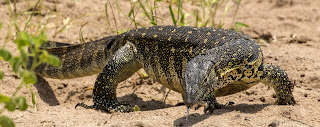 Nile monitor with body raised on semi-erect legs(© Charles J Sharp/Wikipedia –
CC BY-SA 4.0 licence
)
Nile monitor with body raised on semi-erect legs(© Charles J Sharp/Wikipedia –
CC BY-SA 4.0 licence
)
Nowfor the Postosuchus possibility. Onthe one hand, as noted earlier here, in terms of both shape and size areconstruction illustration of this creature was compared quite favourably withthe gbahali's alleged appearance by the villagers to whom Sheppard showed it.Also, its fossils have been found in locations believed to have hosted back inthe time of Postosuchus anenvironment similar to the present-day habitat in Liberia where the gbahalireputedly exists, i.e. tropical, moist, and plant-plentiful, well-supplied withrivers and other expanses of freshwater.
Conversely,Postosuchus belongs to along-extinct, wholly prehistoric family of reptiles known only from what is nowNorth America, and existing during the late Triassic Period, i.e. approximately201-237 million years ago – none of which bodes well for it being a plausibleidentity for the gbahali.
True,we cannot entirely rule out the prospect that the latter constitutes amodern-day Old World descendant of Postosuchusthat has somehow entirely evaded scientific detection (like its presumed fossilantecedents here), especially in such a heavily-forested remote region asnorthern Liberia. Nevertheless, the further back in time that the originalcreature existed, and the further away geographically-speaking that it existedfrom where its postulated descendant does today, the less likely such anexample of prehistoric survival is, by definition.
Inaddition, based upon its shorter forelegs, Postosuchusis nowadays commonly deemed to have been at least partly, if notexclusively, bipedal, whereas the gbahali is wholly quadrupedal. Also, Postosuchus is believed to have beenterrestrial, rather than aquatic or at least amphibious in lifestyle as thegbahali is stated to be.
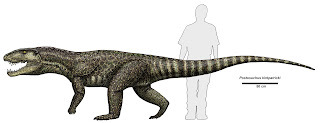 Postosuchus
depicted in bipedal stance and compared in size with a human(Dr Jeff Martz-NPS/Wikipedia, released into the public domain)
Postosuchus
depicted in bipedal stance and compared in size with a human(Dr Jeff Martz-NPS/Wikipedia, released into the public domain)
Anotherputative prehistoric survivor that has been considered as a possible gbahalicandidate is some form of modern-day descendant of Kaprosuchus saharicus. This was a 20-ft-long semi-aquatic speciesof mahajangasuchid crocodyliform that sported an armoured snout for slammingits prey down, plus three pairs of sizeable tusks for tearing the latter'sflesh. These teeth have earned for it the nickname 'BoarCroc', due to theirsuperficial resemblance to the tusks of wild boars.
UnlikePostosuchus, K. saharicus, as its name indicates, did live in Africa (itsfossilized remains have been excavated in what is today Niger), butapproximately 95 million years ago, during the Late Cretaceous. Consequently,it is beset by much the same chronological issues as Postosuchus when under consideration as a plausible example ofprehistoric survival.
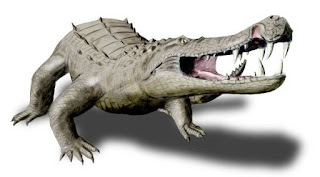 Reconstruction of possible appearance in life of Kaprosuchus Nobu Tamura/Wikipedia –
CC BY 3.0 licence
)
Reconstruction of possible appearance in life of Kaprosuchus Nobu Tamura/Wikipedia –
CC BY 3.0 licence
)
Ifonly there could be a known, historically-recent creature resembling andbehaving rather like the gbahali. In fact, there is – or was. The mekosuchinesconstitute a taxonomic clade of crocodilians that included certainrepresentatives which persisted into the present-day geological epoch, theHolocene (beginning less than 12,000 years ago), on various Pacific islandgroups, including Fiji, Vanuatu, and New Caledonia.
Indeed,one genus, Mekosuchus, survived onthose islands until at least as recently as 3,000 years ago, possibly evenlonger (as late as 1720 BP, i.e. 300 AD, in the case of the youngest species, M. inexpectatus), before apparentlybeing exterminated when humans arrived there (although, tellingly, there is nodirect evidence for this, only speculation based upon the fates of other islandendemics once our own species reached their insular domains). Various other,older mekosuchine genera, such as Quinkana,as well as earlier Mekosuchusrepresentatives, formerly existed on mainland Australia.
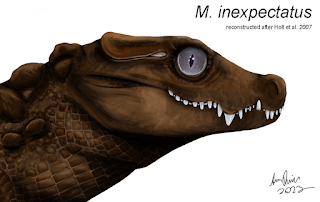 Mekosuchus inexpectatus
, showing neck and short snout (© ArminReindl/Wikipedia –
CC BY-SA 4.0 licence
)
Mekosuchus inexpectatus
, showing neck and short snout (© ArminReindl/Wikipedia –
CC BY-SA 4.0 licence
)
M. inexpectatus in particular wasnotable for its short snout, and like its other historically-recent Mekosuchus kin is thought to haveadopted a much more upright stance and mode of walking than any of today'sknown crocodilians, all of which draws comparisons with the gbahali. So toodoes the consensus that M. inexpectatusprobably inhabited tropical rivers and streams, just like West Africa'spresent-day dwarf crocodiles, possibly coming onto land at night to feed.
Instark contrast to the gbahali, however, mekosuchines were of only very modestdimensions, generally no more than 6 ft in total length, sometimes even shorterthan that. Also, just as Postosuchus isknown only from the New World, mekosuchines are known only from Oceania; thereis none on record from Africa, or anywhere else in the world.
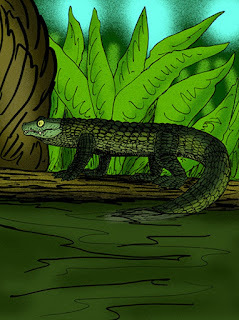 Reconstruction of Mekosuchus inexpectatus in life, Apokryltaros/Wikipedia –
CC BY-SA 3.0 licence
)
Reconstruction of Mekosuchus inexpectatus in life, Apokryltaros/Wikipedia –
CC BY-SA 3.0 licence
)
Evenso, the mekosuchines are relevant to the gbahali saga inasmuch as theirexistence, albeit far-removed geographically from the latter cryptid, confirmsthat at least some crocodilians of comparable appearance to it (excluding totallength) are indeed known from modern times, thus providing a notable precedent– and that may not be all.
Convergentevolution is a familiar phenomenon whereby animals in widely disparategeographical localities and often of only distant taxonomic affinitynevertheless transform through time into outwardly similar creatures due tosharing the same ecological habitat and niche. So could it be thatecologically-speaking, the taxonomically-distant gbahali has nonethelessevolved a mekosuchine morphology by existing in a habitat comparable to that ofthe latter crocodilians, but has attained a much greater size due to itshabitat's remote location coupled with the fear that it generates among humanhunters, who generally prefer to avoid it rather than confront it?
Inshort (unlike the gbahali itself, which is allegedly anything but short!),could Liberia's mystery reptile be a totally novel, as well as a currentlyundescribed, species of African crocodilian?
Alternatively,turning full circle through the succession of identities considered here, mightthis cryptid simply be an unusually large form of Nile crocodiles after all?The reason that I've returned to this option is that I am well aware that thereis a common tendency among local non-scientific people who intimately sharetheir lives alongside large, potentially dangerous creatures to give acompletely separate name to exceptionally large specimens of such a speciesfrom the name that they give to normal-sized specimens of that same species,treating the outliers as a fundamentally different animal type from theirtypically-sized brethren.
Somight it simply be that reports of gbahalis are nothing more than reports ofexceptionally large Nile crocodiles that have been given this separate localname?
Theproblem with such a proposed resolution to the gbahali mystery, however, is thatwe can only accept this by conveniently ignoring the other morphological, andbehavioural, differences from normal Nile crocodiles that the locals ascribe tothe gbahali – which in my opinion would be very unwise.
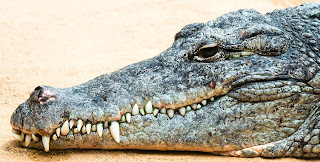 The Nile crocodile's very long snout, differingmarkedly from the gbahali's supposed short snout according to eyewitnesstestimony (© Reinhold Möller/Wikipedia –
CC BY-SA 4.0 licence
)
The Nile crocodile's very long snout, differingmarkedly from the gbahali's supposed short snout according to eyewitnesstestimony (© Reinhold Möller/Wikipedia –
CC BY-SA 4.0 licence
)
Historyhas shown time and again how, by taking heed of local, native testimony,extraordinary animals hitherto dismissed by Western zoologists as mere folklorehave been formally discovered and revealed to be remarkable species entirelynew to science.
So,might the gbahali one day prove to be another one? In view of the giant foresthog, pygmy hippo, Jentink's duiker, and the Liberian mongoose, I'd have tothink more than twice before betting against such a prospect.
For full details concerning the discoveriesof the four Liberian mammals noted above, be sure to check out my three bookson new and rediscovered animals:
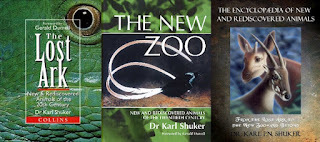 TheLost Ark
,
The NewZoo
, and
TheEncyclopaedia of New and Rediscovered Animals
(© Dr Karl Shuker)
TheLost Ark
,
The NewZoo
, and
TheEncyclopaedia of New and Rediscovered Animals
(© Dr Karl Shuker)
February 24, 2024
DANIELL'S QUAGGA AND WARD'S ZEBRA - ANOTHER TWO STRIPED CURIOSITIES OF THE EQUINE KIND
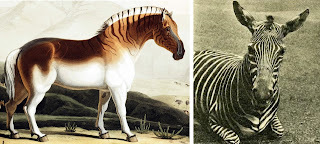 Daniell'squagga (left) and Ward's zebra (right) (public domain)
Daniell'squagga (left) and Ward's zebra (right) (public domain)
Following on from my previousShukerNature article concerning the beautiful but long-forgotten isabella quagga(click here to access it), here are another twoeyecatching but exceedingly obscure striped curiosities of the equine kind, retrievedfrom the annals of zoological history.
DANIELL'S QUAGGA – THE MOST EXTREME QUAGGA OF ALL?
Yes indeed,this particular quagga specimen is so extreme that it makes even the isabellaquagga seem positively commonplace by comparison!
Thespecimen in question is a truly remarkable beast known as Daniell's quagga,after the artist Samuel Daniell (1775-1811), who produced a very handsome aquatintof it in 1804 for his African Scenery andAnimals at the Cape of Good Hope two-part series (1804-1805). He based itupon this quagga form's only known specimen, which had been shot in southernAfrica's so-called Square Mountains (currently unidentified by me) during 1801,but whose skin was not retained.
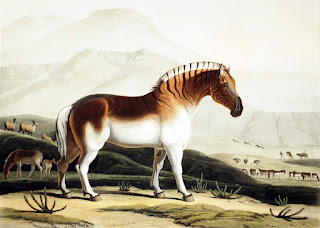 Daniell's quagga, painted by Samuel Daniell as itwould have looked when alive in 1801 (public domain)
Daniell's quagga, painted by Samuel Daniell as itwould have looked when alive in 1801 (public domain)
Whatwas so extraordinary about it, as readily seen in Daniell's painting, is thatthis quagga specimen had exceptionally reduced striping. Indeed, the lattermarkings were confined almost entirely to the sides of the animal's neck, withonly a few very faint lines upon its throat and shoulders, and none at all uponits torso. (True, I have seen paintings of certain other quagga specimens withstripeless torsos, but their throat and shoulders in addition to their neck allbore distinct, conspicuous stripes.) It also had a noticeably large head.
Aswith the isabella quagga, this specimen was initially deemed to represent a newzebra species, dubbed Daniell's quagga, and was accordingly given the speciesname danielli. However, and onceagain like its isabelline relative, Daniell's quagga was later subsumed intothe plains zebra species Equus quaggaas merely a non-taxonomic freak individual.
WARD'S ZEBRA – A ZEBRA CROSSING IN EVERY SENSE!
Ward'szebra is a distinctively-striped, long-eared interspecific hybrid resulting frommatings between plains zebras E. quaggaand mountain zebras E. zebra that wasfirst brought to scientific attention in 1904 via a Proceedings of the Zoological Society of London report by Britishzoologist Prof. J.C. Ewart. In his report, Ewart stated that some yearspreviously he had been presented with a taxiderm zebra specimen, the subject ofhis report, by Rowland Ward, who was a very famous London-based taxidermist atthat time. Ewart had subsequently donated it to Edinburgh's Royal ScottishMuseum (now part of the National Museum of Scotland).
Accordingto Ward, the specimen had originally been "traded out of Somaliland",Somaliland nowadays being recognized as a region within Somalia. However, Ewartspeculated that its kind "probably inhabits part of the area between theupper reaches of the Tana River and Lake Rudolf [later renamed LakeTurkana]", in Kenya.
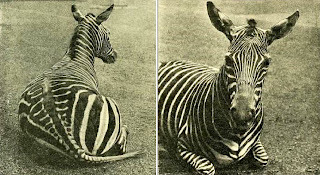 Ward's zebra - two views of Ewart's erstwhile taxidermhybrid specimen, from his 1904 PZSLreport (public domain)
Ward's zebra - two views of Ewart's erstwhile taxidermhybrid specimen, from his 1904 PZSLreport (public domain)
Ewartwas struck by the specimen's overall similarities to South Africa's Cape mountainzebra (E. z. zebra; Hartmann'smountain zebra E. z. hartmannaeoccurs in Namibia and Angola), but also noting in detail various differences inits striping, as well as its very long ears. Clearly not suspecting its hybridnature, Ewart concluded his report by suggesting that it may constitute a new formof Kenyan plains zebra, duly dubbing it Ward's zebra in honour of itsprocurer, which "is adapted to a habitat similar to that of the mountainzebra", i.e. an example of convergent evolution.
In1910, moreover, Ward's zebra was formally named Equus wardi, but its hybrid status was revealed via the discoverythat specimens of this zebra form had been obtained repeatedly in the Jardindes Plantes, Paris, around 1900. And in 1915, a male specimen was obtained atLondon Zoo. Indeed, some authorities have opined that Ewart's specimen haditself probably been bred in a menagerie, rather than originating from either thewilds of Somaliland or of Kenya.
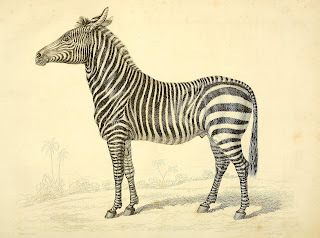 Vintageengraving of the Cape mountain zebra, 1830 (public domain)
Vintageengraving of the Cape mountain zebra, 1830 (public domain)
February 19, 2024
THE ISABELLA QUAGGA - A LONG-LOST, LONG-FORGOTTEN EQUINE ENIGMA
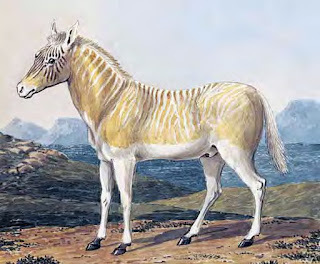 Abeautiful vintage (1800s) full-colour engraving of the unique isabella quagga(public domain)
Abeautiful vintage (1800s) full-colour engraving of the unique isabella quagga(public domain)The quagga Equus quagga quagga is nowadays famous for two very differentreasons. Firstly: it is – or was – the only semi-striped form of zebra, itsstriping being confined to its foreparts. Secondly: although once common in itsSouth African veldt habitat, it was hunted into extinction there during thesecond half of the 19th Century, with the very last captivespecimen's death in Amsterdam Zoo on 12 August 1883 marking the tragicdisappearance of this highly distinctive equid from the face of our planet – thoughThe Quagga Project continues its aim to recreate this vanished creature's characteristicphenotype (external appearance) via back-breeding, using striping-depletespecimens of other Equus quaggasubspecies to produce quagga facsimiles.
Speaking of which: today, the quagga is classedas a subspecies of the plains zebra Equusquagga, but back in the mid-1800s when still very much alive it was deemedto be a valid, distinct species in its own right, and was dubbed Hippotigris quacka (hippotigris beingthe name given to zebras by ancient scholars who believed these exotic-looking stripedequids to be the product of matings between horses and tigers!) – see later forfurther taxonomic details. But that is not all.
Oneof five precious photographs of an adult quagga mare living at London Zoo from 15 March 1851 until her death there on 15 July 1872 – these arethe only known photos of a live quagga (click here for more details concerning this quagga quintet)
For a time during that same period, asecond, very remarkable quagga species was also recognized, despite being knownfrom just a single specimen – a poorly-preserved skin formerly held at theBritish Museum in London. This unique, extraordinary-looking animal becameknown as the isabella quagga, but today the skin is long lost and the isabellaquagga itself is long forgotten. Consequently, I felt that what (very) littleis known about this beautiful if baffling enigma of an equid richly deserved tobe collated and presented in article form in order for modern-day readers tobecome aware of its erstwhile existence. So here is the hitherto-obscurehistory of the long-overlooked isabella quagga – a ShukerNature exclusive.
I first learned of the isabella quagga Hippotigris isabellinus many years ago,when I chanced upon the following previously-obscure yet fascinating excerptfrom a quagga-themed communication by famous British zoologist Richard Lydekkerthat had been published by the scientific journal Nature on 10 January 1901. The excerpt alluded to a supposedlyseparate, second species of quagga, again extinct:
...the British Museumformerly had the skin of a young quagga, in very bad condition, which waspresented by the traveller William Burchell [after whom Burchell's zebra is named],and was subsequently described by Hamilton Smith as a distinct species, underthe name of Hippotigris isabellinus.
Twopoints to note here. Firstly: the above-mentioned Hamilton Smith was CharlesHamilton Smith (1776–1859), a lieutenant-colonel in the British Army. He wasalso a naturalist who scientifically described and named several equine speciesand subspecies. In two 1841-published tomes referred to later here, he dubbedthis enigmatic animal the isabella quagga. Secondly: whereas all zebra speciesand subspecies are nowadays housed in the genus Equus (alongside horses and asses), back in Lt-Col. HamiltonSmith's time several were housed in their own separate genus, Hippotigris, including the normalquagga, which was formally deemed back them to be a valid species in its ownright (rather than merely a subspecies of the plains sebra, as it is classifiedtoday) and was duly known as Hippotigrisquacka.
Lydekker's communication then continued with thefollowing text, but it is unclear whether this text was still referring to theisabella quagga or (as I suspect) had returned to the communication's primarysubject, the normal quagga:
Apparently Londonmuseums possess no other relics of this lost species, of which, however, webelieve there is a specimen in the museum at Edinburgh. As the animal yieldedno trophies worthy the attention of the sportsman, it is unlikely that thereare any specimens in private collections, unless, perchance, a skull or two maybe in existence.
The remaining text in Lydekker's communicationunequivocally referred to the normal quagga, so it needn't be quoted here.
What exactly was the isabella quagga, I wondered,when I first began researching this curious creature, and what did it even looklike, bearing in mind that Lydekker provided no description of it in hiscommunication and the British Museum no longer has it?
Back in pre-internet times, it was by no means easyto research anything as unimaginably obscure as the isabella quagga, so aftervarious attemptss to solicit more information concerning it all proved futile,I placed Lydekker's intriguing communication on file and directed my attentionto other subjects. Notwithstanding these failures, however, I never forgotabout it, so when I was checking some details recently while completing someother researches and noticed it again, still on file, I decided to reinvestigateits elusive subject, but now assisted enormously by the vast wealth of datareadily accessible online. And this time, finally, I was successful, as nowrevealed.
Originally, my only clue had lain in its moniker.For in this instance, isabella refers not to a woman's name but instead to acolour, known in full as isabelline, and which constitutes this mysteryquagga's species name, isabellinus.It is variously defined as pale grey-yellow, pale fawn, palecream-brown or parchment colour, and is primarily utilised in relation tomammalian coat colour and bird plumage.
Presumably,therefore, I mused, this shade was the background colouration of the coat ofthis unique specimen (a male, incidentally), meaning, if so, that it was palerin appearance than normal quaggas and probably with fainter stripes too.Whether such a difference warranted Hamilton Smith naming it as a separatespecies, however, when it was surely nothing more than an aberrantly pallid(possibly leucistic?) specimen of the normal quagga (see later), was anothermatter.
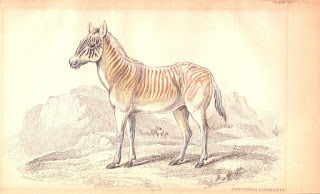 The pale-coloured engraving of the isabella quaggafrom Hamilton Smith's two 1841 tomes (public domain)
The pale-coloured engraving of the isabella quaggafrom Hamilton Smith's two 1841 tomes (public domain)
Duringmy recent researches, I uncovered two beautiful vintage engravings illustratingthe isabella quagga, both of which represent it in the living state. One ofthese engravings is hand-coloured in very pale shades with minimal backgroundcolouration. The other engraving is in full-colour, so it is much more vibrant.
Itraced the pale engraving back to a couple of tomes from 1841, which upon closeexamination turned out to be identical in content but bearing different titles.One is entitled Horses, andconstitutes Volume 20 of the massive 40-volume series edited by Sir WilliamJardine and entitled The Naturalist'sLibrary. The other tome is exactly the same but is retitled as The Natural History of the Horse andconstitutes a stand-alone volume. In both tomes, the author is given as CharlesHamilton Smith, and a concise section documenting what he specifically refersto as the isabella quagga is included, containing the pale engraving of thisspecimen. In both tomes, it is designated as Plate 25, and is credited toHamilton Smith.
In hisduplicated 1841 tomes, Hamilton Smith began his brief coverage of the isabellaquagga (pp. 332-334, and which constitutes this claimed species' formalscientific description and naming) by stating that although this animal's bodyshape (including its head) compared closely with that of the normal quagga, hehad separated it from the latter equid because it differed by virtue of itssmaller size (barely 10 hands, i.e. 40 in, tall) and even more so by the formsand colour of its stripes.
Hethen referred to an unidentified equid seen by travelling French naturalistFrançois Le Vaillant (1753-1824), presumably in South Africa's Cape as this iswhere he had spent time collecting animal specimens, and which he'd named thezebre but was apparently different from those zebras already known from there.Some zoological authorities, including Dutch zoologist Coenraad Temminck (whosefather was Le Vaillant's employer) had considered the isabella quagga to be LeVaillant's zebre, but Hamilton Smith disagreed with their opinion.
Theremainder of Hamilton Smith's account consisted of a verbal description of theisabella quagga skin (augmenting the engraving of this animal portrayed in theliving state), which included his belief that it was an adult rather than ajuvenile specimen despite its small size, and was not albinistic. Conversely,when concluding his account by mentioning that a Dr Leach had believed the skin(which still existed at the British Museum at this time) to have originallycome from the Cape, he conceded that Leach had considered its pale colouration,especially its white stripes, to be due to the animal's 'nonage' (young age).
Moreover,it should be noted here that back in Hamilton Smith's time, there was asomewhat naïve but very prevalent tendency among taxonomists to over-emphasisethe significance of individual variation within species, leading to thesplitting off and naming of many spurious animal species that in reality werenothing more than freakishly-coloured/patterned individuals of already known,confirmed species. Eventually, however, such shortcomings were rectified bylumping these unsubstantiated species back together – as happened with theisabella quagga, subsequently being subsumed by zoologists into the normal quaggaspecies (now subspecies).
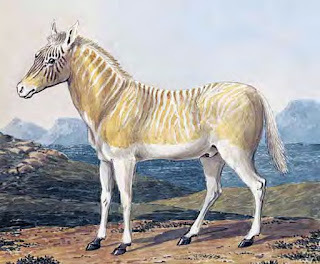 The currently-unsourced full-colour engraving ofthe isabella quagga (public domain)
The currently-unsourced full-colour engraving ofthe isabella quagga (public domain)
As forthe full-colour isabella quagga engraving: regrettably, I have not identifiedits original published source so far, but my search for it continues.
Irrespectiveof such matters, the two engravings readily confirm my early deductions as tothe isabella quagga's likely appearance – namely, an aberrantly pale,isabelline-coloured quagga with only very faint, white striping.
Havingviewed several comprehensive lists of quagga material currently housed inmuseums worldwide, I can confirm Lydekker's statement that the isabella quaggaskin deposited by Burchell at what is now London's Natural History Museum is nolonger there, and is therefore lost. Presumably it was discarded due to itsvery poor condition, but a tragic loss nonetheless of such an exceptional,unique specimen, and which nowadays might well have yielded much usefulinformation via DNA tests conducte3d upon samples of this skin's tissues.
Yetdespite the isabella quagga having long since been reduced in status from ataxonomically-discrete species to a non-taxonomic mutant oddity, its delicatepallid beauty deserves to be remembered and celebrated. So I am very glad thatI discovered this elegant animal hidden away as the briefest of footnotes withinthe dusty archives of the past, and have been able to revive it, even if onlyin words and pictures, within this present ShukerNature blog article, writtenup at last.
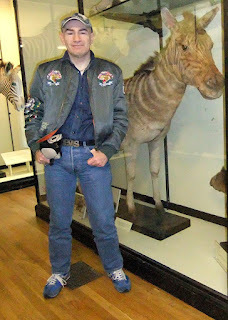 Alongsidea mounted quagga specimen at Tring Natural History Museum, England (© Dr KarlShuker)
Alongsidea mounted quagga specimen at Tring Natural History Museum, England (© Dr KarlShuker)
Karl Shuker's Blog
- Karl Shuker's profile
- 45 followers



